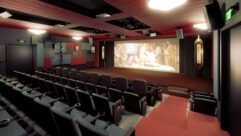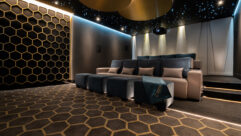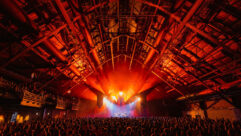THE BEST SEATS IN THE HOUSE
Nov 1, 2002 12:00 PM,
By Christian Doering
When Miami Dolphins owner Joe Robbie arranged the private financing and construction of the $115 million Pro Player Stadium in the late 1980s, he revolutionized the economics of professional sports stadiums. Since then Pro Player Stadium has hosted numerous Super Bowls as well as regular season and play-off games involving its two home teams, the Dolphins and the Florida Marlins. Originally named for Joe Robbie, the venue’s title was changed to Pro Player Stadium when Pro Player, a division of Fruit of the Loom, bought the rights to the name in 1996.
As the first professional sports facility to include luxury suites and extensive on-site advertising opportunities, Pro Player Stadium set the pattern for a new generation of sports venues. But more recently constructed venues have been able to take advantage of developments in audio technology to further enhance the game experience for fans in the bleachers as well as the skyboxes. The owners decided it was time to upgrade the stadium to maintain its position as one of professional sports’ most advanced and prestigious venues. Wrightson, Johnson, Haddon, and Williams (WJHW) of Dallas was hired to design the new system. WJHW has a strong working relationship with HOK, the architect for Joe Robbie, and the firm has designed many successful sound systems for HOK sports venues around the world. Its ongoing relationship with the stadium made WJHW the obvious choice to bring the audio facilities up to date for the new millennium.
“We had been talking with the operations personnel at the stadium for almost ten years about upgrading the sound system,” says Ron Baker, principal at WJHW. Pro Sound of Miami was the winning contractor with a bid that included site supervision, engineering, final terminations, and testing of the upgraded sound system.
A NEW STANDARD
The new design by WJHW replaced a scoreboard cluster that had long occupied the east side of Pro Player Stadium. Designed by Joiner-Rose Group in 1985 and installed during the initial construction of the facility, the system had served the players, owners, and fans well for almost 20 years. Although many aspects of the design reflect proven WJHW techniques — such as high-output loudspeaker systems distributed around the upper edge of the bowl as well as the front and underside of the top level — Pro Player Stadium’s system breaks new ground in the processing and distribution of digital audio. The backbone of the system is the world’s largest mLAN network.
WJHW’s design mandate was to enhance both the intelligibility of announcements and the quality of music playback in the stadium. To accomplish those goals, the speakers were distributed around the venue and separated into two levels. JBL’s Custom Shop worked with WJHW to develop site-specific loudspeaker systems using JBL‘s Precision Directivity (PD) technology.
THE CONTROL ROOM
The system operators were able to make the transition to the new system easily, because much of the front-end equipment — such as a Mackie 32-by-8 console that is used to select from various sources such as CD playback and the announcer’s mic — has remained in place. The operators normally don’t need to touch anything after the mono console outputs: this is a sports stadium, after all, not a home theater.
WJHW added two improvements to the analog portion of the signal chain. The first was a LynTec Crowd Compensator for keeping the system’s output level in balance with the ambient-noise level. As installed at Pro Player Stadium, the LynTec system uses a single ambient-sensing microphone that is located above and outside the control room. Fast Fourier transform filters enable the Crowd Compensator to distinguish between program music or announcements played back by the sound system and ambient noise generated by the fans. Pro Sound programmed the unit to adjust the program levels automatically so that the program level is always about 9 dB above the noise of the crowd.
The second addition is an Aphex Systems Dominator limiter between the Mackie board and a Yamaha DME32 digital mixing engine to make sure the A/D converters don’t clip. The initial A/D conversion is done by the DME32, which outputs digital audio through two mLAN cards. A Yamaha MY4-DA card converts the digital signal back to analog so that it can travel along a backup copper signal path to the two amplifier rooms. Once it reaches the amp rooms, the analog signal is converted back to digital by an MY4-AD card in one of the remote-located DME32s.
The digital signals travel via six-pair multimode fiber-optic cable to the two amplifier rooms, one on the east side and the other in the west side of the stadium. In each amp room, additional DME32s, two in the east amp room and four in the west, perform all loudspeaker management signal-processing functions, such as equalization, crossovers, protection limiting, and delay. The DME32s route appropriately processed signals to the QSC Audio amps. Copper speaker wire then delivers the amplifiers’ output to the various speakers located around the upper and lower decks.
After discussing the available choices and comparing notes on previous projects, WJHW and Pro Sound agreed on the DME32 as the centralized digital signal-processing (DSP) “system brain” for the project. “The main priority for all parties involved was finding a reliable DSP,” says Scott Pearson of Pro Sound. “We have been using the DME32 at the Orange Bowl in Miami now for more than a year with no problems, so we were confident of the DME32’s reliability. The modular architecture of the DME32 and its programming accessibility without a computer are also important factors.” Pro Sound has maintained Pro Player Stadium’s original sound system for the past decade without a single critical failure, and the company clearly expects the Yamaha units to help it maintain that record.
“Sound quality was just as important,” Pearson says. “We were aware that many DME32 components are also used in Yamaha’s PM1D digital mixing console. Any technology that can withstand the rigors of touring and satisfy touring professionals’ audio-quality issues would certainly be appreciated in any pro-sports facility. Finally, the cost savings that the DME32 provided allowed us to provide the owner with additional equipment while staying within the project budget.”
The DME32s have plenty of processing work to do in driving the JBL Precision Directivity loudspeaker systems. First installed as part of a WJHW design for the American Airlines Center in Dallas, the PD line includes seven models: two coaxial horn-loaded mid/high modules, three midbass modules using 12-inch cone transducers, and one 15-inch and one 18-inch low-frequency modules. The XPD LF modules used at Pro Player Stadium are derived from JBL’s PD125 dual-15 LF modules. A frontally oriented lobe is typically obtained from eight of those modules by applying separately delayed signals to each module.
Adjacent low-frequency sources cancel each other at half-wavelength spacing; by using delayed signals, the designer can manipulate the effective spacing between adjacent sources to control the shape and direction of the resulting lobe. The Precision Directivity concept leaves room for frequency shading to be used when a slightly wider but smoother polar pattern is desired at the expense of some reduction in maximum sound-pressure level. The PD line also includes PD162 midbass modules, which are normally arrayed in sets of three, with a total of 14, 12-inch woofers and 7 separately delayed signals.
Thermal and excursion limiting, EQ, and crossover functions are also required for optimum audio quality and reliability. Six DME32s, four in the west amp room and two in the east room, provide those functions, using between 70 and 90 percent of the available DSP capacity. “Once the DME32 was chosen as the DSP for the project, Yamaha’s reputation for reliability and digital sound quality made the choice of a network for interconnecting and managing our digital-audio signals an easy decision,” Pearson says. “MLAN allowed us to use an integrated solution to transmit digital audio, and the mLAN protocol affords us greater flexibility in our DSP programming, allowing us to better share DSP resources throughout our network.”
The Pro Player Stadium upgrade is the world’s largest mLAN network, using fiber-optic cable to transmit digital audio between three widely separated equipment locations: the control room and the two amplifier rooms, which are located 1,200 feet and 600 feet away on the east and west sides of the stadium.
SEAMLESS NETWORK
Developed by Yamaha but available as a free license (with 30 licensees around the world, including Otari and Korg), mLAN is an audio layer that uses the physical layer (cables and connectors) and the transaction layer (basic networking protocol) of FireWire. FireWire is only six years old, was invented by Apple specifically for multimedia, and won a technical Emmy last year. It’s already revolutionized the video production industry by hot-plugging digital video cameras into desktop computers running video-editing software. Although FireWire on copper has about a 13-foot (4m) distance limitation, the digital audio and control signals at Pro Player ride on glass fiber with NEC MX/GF4 repeaters. This combination is able to transfer the data up to 1,500 feet (about 500m). The longest fiber run at Pro Player is 1,200 feet, well within the distance capability of this combination.
Thanks to the fiber network, all seven DME32s can send and receive perfect digital copies of the console output. Along with mLAN digital audio, the fiber network carries RS232 control signals for the DME32s so that all seven units can be controlled from a single PC in the control room. QSControl signals are also delivered to and from the amp rooms on the same fiber. This allows the system operator to monitor and control the signal processing and the amplifiers without leaving the control room.
POWER PLAY
The signal path at Pro Player Stadium accumulates branches quickly. In the amp rooms, the DME32s deliver signal to racks of QSC amplifiers. PowerLight 4.0s drive the XPD speakers while CX1102s power the mid/high cabinets. Fans seated underneath each scoreboard listen to distributed fill speakers, powered by CX1202Vs on a 70V line. All the QSC amplifiers use QSC’s PowerWave switching power supply, and all are controlled and monitored remotely through QSControl. At Pro Player Stadium, the bidirectional QSControl data is transmitted over Ethernet through the same multimode glass fiber as the digital audio and the RS232 control signals for the remotely located DME32s. It takes a lot of amplifier channels to power 350 loudspeakers, as can be seen from the number of QSC CM-16A amplifier network monitors that are used in the amp rooms: there are 14 CM-16As in the west amp room and five more on the east side. Each CM-16A can monitor and control as many as eight Dataport-equipped QSC amplifiers and communicates with the host computer through Ethernet. At Pro Player Stadium, the operators use QSC’s System Manager software that runs under Windows. There was no need to build a custom Visual Basic interface using the available QSControl development tools.
The principle differences between the various QSC amplifiers used at Pro Player are power output and load options. The CX1102 delivers 1,700W per channel into a 2ž load, and the CX1202V can drive a 70V line at 800W. The PowerLight 4.0 is rated at 2,000W per channel into 2ž. Traditional copper wire connects the amplifier outputs to the loudspeakers. With 350 loudspeakers to connect, Pro Sound’s installation crew had plenty of details to check and double-check during the installation.
THE FAST TRACK
From its offices in Miami, Orlando, Las Vegas, and Los Angeles, Pro Sound has installed more than 40,000 audio, lighting, and control systems since its inception in 1975. Having worked in the Tampa Buccaneers’ Raymond James Stadium; in the Tampa Bay Devil Rays’ Tropicana Field; on Super Bowls XXIII, XXIX, and XXXV at Pro Player Stadium; and on Super Bowl XXV at Raymond James Stadium, Pro Sound was familiar with the facility and with the needs of pro-sports operations. Still, every project has its own unique challenges: timing was a major one in the Pro Player Stadium renovation. “We were hired in March, and we had to be finished by August 15 so the Dolphins could use the system for their first preseason game,” Pearson says. “The weather dictated that work take place during the hottest months of the year in Florida and during the Marlins’ season.”
Pro Sound kept the old system running throughout the installation, Pearson says. “We had a one-week window during a Marlins road trip when we could do all the testing and commissioning and switch over to the new system,” he says. A week is not a lot of time for a sound system that serves 75,000 fans and includes 350 loudspeaker systems. MLAN, RS232, and QSControl were essential to completing the testing and commissioning process within the one-week window allowed by the Marlins’ baseball schedule. “Except for stadium ops, no one could tell that we were replacing the old P.A. system,” Pearson says. “The installation was seamless.”
So far fan response to the new system has been positive. With a leading-edge digital-audio system in place, Pro Player Stadium is ready to maintain its reputation and position as one of professional sports’ most highly regarded outdoor venues. Fans of the Dolphins and Marlins will continue to enjoy the experience of supporting the hometown heroes for years to come.
Christian Doering is a marketing partner of Dynamic Market Systems.
For More Information
Aphex Systems
www.aphex.com
℘ 249
Apple
www.apple.com
℘ 250
JBL
www.jbl.com
℘ 251
Korg
www.korgusa.com
℘ 252
LynTec
www.lyntec.com
℘ 253
Mackie
www.mackie.com
℘ 254
NEC
www.nec.com
℘ 255
Otari
www.otari.com
℘ 256
QSC Audio
www.qscaudio.com
℘ 257
Yamaha
www.yamaha.com
℘ 258
℘ Circle this number on Reader Service Card or visit freeproductinfo.net/svc










